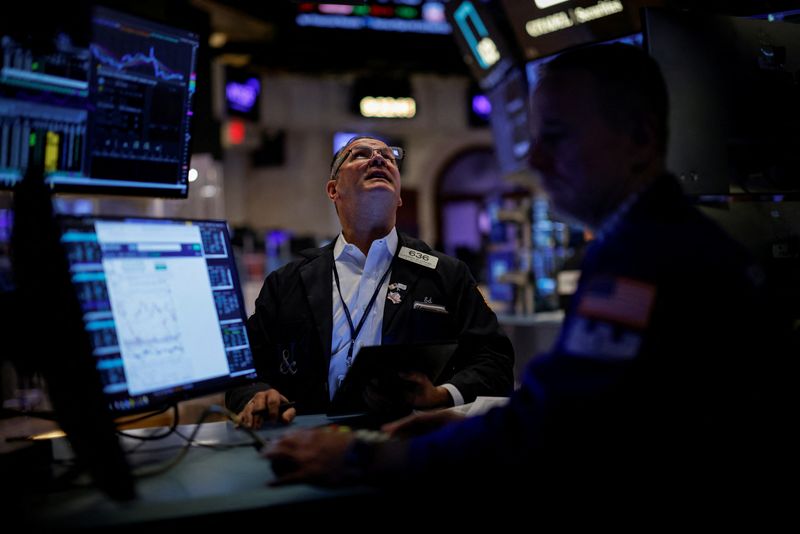US jobs report could firm or upend Fed “base case” of quarter-point cuts

By Howard Schneider
WASHINGTON (Reuters) – In U.S. Federal Reserve officials’ latest projections and recent public commentary, the overall economy is seen remaining in solid shape but the job market is seen as weakening and a subject of increasingly intense concern.
Fed Chair Jerome Powell this week acknowledged that “tension” and said employment data in the months ahead, rather than other economic indicators, “may give a better real time picture” of how the economy is evolving.
First up is Friday’s employment report for September. It may prove key in determining whether the “base case” Powell pointed to of quarter-point rate cuts at the Fed’s remaining two meetings this year remains intact, or the debate gets tilted towards a larger cut if job growth slows unexpectedly or even a pause if, for example, wages unexpectedly spike.
In delivering a half-point cut in September, Fed officials said their sense of the risks facing the economy had become skewed toward higher-than-expected unemployment. A dozen Fed officials saw “upside” risks to the job market versus only four in June’s projections. Only three saw much risk of an inflation surge.
Friday’s payrolls report will be a first glimpse into whether those job risks are materializing, with close attention paid not only to topline figures like the unemployment rate and job creation but also to such details as wage growth and the number of long-term unemployed, which has been rising in a sign of more difficult conditions for jobseekers.
“RESILIENCE” AT RISK?
In a study last week for Evercore ISI analyzing the economic projections the Fed issued after its Sept. 17-18 meeting, former top Fed economist John Roberts said the fact that rate cuts were coupled with an expected, if slight, rise in the unemployment rate “suggest that the resilience that had characterized the U.S. economy as recently as June – with a strong economy despite high interest rates – has largely disappeared.”
Risks were tilted towards worse rather than better outcomes, Roberts wrote, and all things equal the Fed’s new policy rate of 4.75%-5.00% may be putting more pressure on the economy than expected.
In an interview with Reuters this week, Atlanta Fed President Raphael Bostic said if monthly net job growth falls much below 100,000, the approximate breakeven rate he feels is needed to accommodate new entrants to the labor market, he’d take it as evidence the Fed may need to cut rates faster.
Ufuk Akcigit, a University of Chicago economics professor who has helped develop a hiring index using data on small business from software firm Intuit (NASDAQ:INTU), said the trends he sees are concerning – with job growth in decline even as firm revenue has held up.
Small business employment fell by nearly 5,000 from August to September, continuing a drift lower that suggests firms have become more anxious. “Given how fragile the environment is, hiring someone is a big decision,” he said. “They are acting more risk averse.”
Economists polled by Reuters still expect employers added 140,000 jobs last month.
Bostic said he is in no “dash” to cut rates, but the central question has become “is the economy still producing net jobs?…What is the aggregate number and how is that looking?”
He said that while the “steady state” rate for job growth is hard to estimate, given uncertainty around issues like immigration, numbers below 100,000 would prompt “another layer of questioning to understand to what extent is this an anomalous reading…or is it pointing to something that’s more fundamental?”
Bostic said he will also be watching how many industries add jobs “to see, is it broad-based or is it isolated in a particular sector or not?”
UNEMPLOYMENT AT EQUILIBRIUM?
By many measures the current U.S. unemployment rate of 4.2% is pretty good, and is considered particularly so by Fed policymakers in the context of how fast and far inflation has fallen, since dramatic drops in price pressures are more typically associated with sluggish growth or outright recessions and high levels of joblessness.
The unemployment rate as of August was well below the 5.7% average jobless rate seen since the late 1940s. Importantly for the Fed, it is now right at the level the median policymaker sees as consistent with the Fed’s targeted 2% inflation rate over the long run.
But joblessness has also been rising steadily for more than a year – enough so to trigger some dependable recession indicators. By the Fed’s own projections, it is due to rise at least a bit more.
The historical track record is not good on that front. Once increases in the unemployment rate hit more than half a percentage point over the course of a year, the tendency has been for larger increases to follow. That’s something policymakers will have in mind when reviewing the latest headline numbers.
“The levels of unemployment are fine, but the trend line isn’t all that good,” Richmond Fed President Thomas Barkin said. It’s an open question on whether it is settling into “the right level” near what’s considered sustainable month to month or about to crash through that level on the way up.
Investors by a nearly two-to-one margin currently expect the Fed to trim the benchmark rate another quarter of a point at the Nov. 6-7 meeting, an outlook that Friday’s data could either confirm or begin to reshape.
“With every meeting, we’ll get one or two more jobs reports. We’ll get one or two more inflation reports. You’ll get ever-increasing confidence if you’re right, and then, if the data comes in in a different way, you have the ability to react appropriately,” Barkin said.







